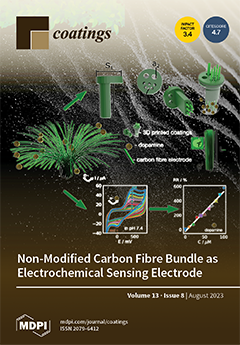Multinary chalcogenides with Kesterite structure Cu
2ZnSn(S,Se)
4 (CZTSSe) are a prospective material base for the enhancement of the photovoltaics industry with abundant and environmentally friendly constituents and appropriate electro-physical properties for building highly efficient devices at a low cost with a
[...] Read more.
Multinary chalcogenides with Kesterite structure Cu
2ZnSn(S,Se)
4 (CZTSSe) are a prospective material base for the enhancement of the photovoltaics industry with abundant and environmentally friendly constituents and appropriate electro-physical properties for building highly efficient devices at a low cost with a short energy pay-back time. The actual record efficiency of 13.6%, which was reached recently, is far below the current isostructural chalcopyrite’s solar cells efficiency of near 24%. The main problems for future improvements are the defects in and stability of the Kesterite absorber itself and recombination losses at interfaces at the buffer and back contacts. Here, we present an investigation into the rapid thermal annealing (RTA) of as-electrodeposited thin films of Cu
2ZnSnS
4 (CZTS). The treatment was carried out in a cold wall tubular reactor in dynamic conditions with variations in the temperature, speed and time of the specific elements of the process. The effect of annealing was investigated by X-ray diffractometry, Raman scattering and Scanning Electron Microscopy (SEM). The phase composition of the films depending on treatment conditions was analyzed, showing that, in a slow, prolonged, high-temperature process, the low-temperature binaries react completely and only Kesterite and ZnS are left. In addition, structural investigations by XRD have shown a gradual decrease in crystallite sizes when the temperature level and duration of the high-temperature segment increases, and respectively increase in the strain due to the formation of the phases in non-equilibrium conditions. However, when the speed of dynamic segments in the process decreases, both the crystallite size and strain of the Kesterite non-monotonically decrease. The grain sizes of Kesterite, presented by SEM investigations, have been shown to increase when the temperature and the duration increase, while the speed decreases, except at higher temperatures of near 750 °C. The set of experiments, following a scrupulous analysis of Raman data, were shown to have the potential to elucidate a way to ensure the fine manipulation of the substitutional Cu/Zn defects in the structure of CZTS thin films, considering the dependences of the ratios of Q = I
287/I
303 and Q′ = I
338/(I
366 + I
374) on the process variables. Qualitatively, it can be concluded that increases in the speed, duration and temperature of RTA lead to increases in the order of the structure, whereas, at higher temperatures of near 750 °C, these factors decrease.
Full article
 to open them.
to open them.




